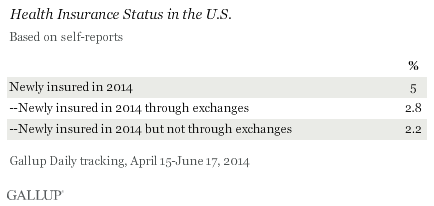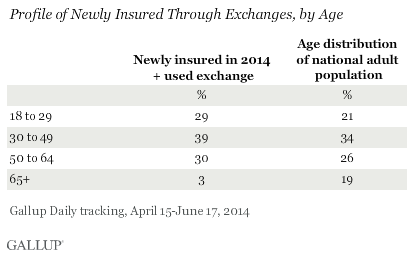PRINCETON, NJ -- Five percent of Americans report being newly insured in 2014. More than half of that group, or 2.8% of the total U.S. population, say they got their new insurance through the health exchanges that were open through mid-April.

These data are based on Gallup Daily tracking interviews with more than 31,000 adults conducted between April 15 and June 17. Those who say they have health insurance were asked if their policy was new for 2014, and if so, whether they obtained their policy through a state or federal health exchange or in some other way. The exchanges officially closed on March 31, although people who indicated they had begun the process prior to that date were allowed to continue to enroll through April 15.
The preliminary April 16 Gallup update on the newly insured was based on data collected from March 4-April 14, and showed that 4% of all adults on average during that period reported being newly insured, with 2.1% reporting that they gained their insurance through an exchange.
The March-April report was based on interviews conducted evenly across that six-week period, and thus, many in that sample who ultimately got insurance may not yet have had it at the time they were interviewed -- particularly earlier in March. All of the April-June interviews were conducted after the exchanges closed, and therefore these reports provide a representative portrait of the post-enrollment health coverage of the population. The increase in self-reported newly insured status from the preliminary report also dovetails with recent stories reporting surges in enrollments as the exchange enrollment period came to a close.
Many of those who enrolled in the first half of April would not see policy coverage begin until May 1 or, in some cases, one month after enrollment. Thus, the earlier report may have included individuals who did not report having insurance this year because their policies had not yet taken effect. That same situation may apply to a lesser degree to those interviewed in the current group, meaning the estimate that 5% are newly insured may itself underrepresent the percentage of Americans who ultimately will have new insurance this year.
Newly Insured Through Exchanges Are Younger
The age distribution of those who report newly obtaining health insurance this year through the exchanges is generally similar to what Gallup found in the preliminary report. The newly insured using exchanges are mostly under age 65, as would be expected, given that most Americans 65 and older are covered by Medicare. Thus, the representation of newly insured Americans is higher across all three age groups younger than 65 than is true for the general population. More specifically, newly insured Americans using the exchanges in the 18 to 29 age category are eight percentage points more prevalent than their percentage in the overall adult population, while representation of those 30 to 49 and 50 to 64 are five and four points higher, respectively.

Newly Insured Report Being Less Healthy Than Average Adults
One catalyst for the individual healthcare mandate was to bring healthy people who otherwise chose not to have health insurance into the healthcare system using the exchanges. However, as was the case in the previous sample, the newly insured using exchanges in the April-June reporting period are less likely than those in the general population to report being in "very good" or "excellent" health. Thirty-eight percent of those using an exchange for their new policies reported being in very good or excellent health, compared with 50% of the general population.

Implications
The 5% of the adult population who report getting health insurance this year and who did not have it last year is roughly commensurate with the overall drop in the uninsured percentage of the overall population between the third quarter of 2013 and April-May of this year. Still, even after meeting and exceeding established goals of 7 million enrollees through healthcare.gov and with probable spillover effects into non-exchange-based new enrollments, millions of Americans still are without health insurance: the total percentage of the adult population who are uninsured remains above 13%.
If the federal government wishes to continue to expand the pool of enrollees in the next open enrollment period, which begins on Nov. 15, it may have to intensify its current outreach strategies to motivate resistant citizens to enroll. Investing resources into attracting more enrollees would align with the plan to increase fines in the coming enrollment period for those without minimum essential coverage.
Survey Methods
Results for this Gallup poll are based on telephone interviews conducted April 15-June 17, 2014, on the Gallup Daily tracking survey, with a random sample of 31,438 adults, aged 18 and older, living in all 50 U.S. states and the District of Columbia.
For results based on the total sample of national adults, the margin of sampling error is ±1 percentage point at the 95% confidence level.
Interviews are conducted with respondents on landline telephones and cellular phones, with interviews conducted in Spanish for respondents who are primarily Spanish-speaking. Each sample of national adults includes a minimum quota of 50% cellphone respondents and 50% landline respondents, with additional minimum quotas by time zone within region. Landline and cellular telephone numbers are selected using random-digit-dial methods. Landline respondents are chosen at random within each household on the basis of which member had the most recent birthday.
Samples are weighted to correct for unequal selection probability, nonresponse, and double coverage of landline and cell users in the two sampling frames. They are also weighted to match the national demographics of gender, age, race, Hispanic ethnicity, education, region, population density, and phone status (cellphone only/landline only/both, and cellphone mostly). Demographic weighting targets are based on the most recent Current Population Survey figures for the aged 18 and older U.S. population. Phone status targets are based on the most recent National Health Interview Survey. Population density targets are based on the most recent U.S. census. All reported margins of sampling error include the computed design effects for weighting.
In addition to sampling error, question wording and practical difficulties in conducting surveys can introduce error or bias into the findings of public opinion polls.
For more details on Gallup's polling methodology, visit www.gallup.com.
